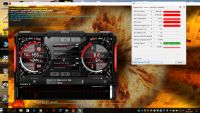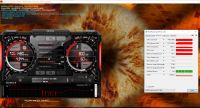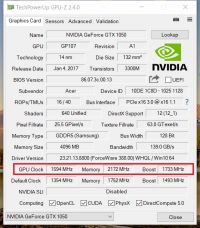Hello all!
I have a question about overclocking the graphics card in a laptop
My graphics card in the ACER laptop is GTX 1050 4GB DDR5, I turned it up with MSI AfterBurner.
During overclocking, of course, the temperature and the increase in voltage - grew steadily. After reaching the maximum overclocking limit of my card without artifacts or crashing FurMark, the voltage dropped from what I remember about 0.5V and the temperature dropped from 65 degrees to 60 and so all these times remain with the clock overclocked and the memory of the GTX 1050 graphics card overclocked.
Is it normal for the temperature and voltage of the card to drop after overclocking? Should I get ready for something terrible?
Photos and results of overclocking can be shown but only at about 17 when I return home from work.
Greetings to everyone and waiting for an answer.
Mateuszek OC Master '
Added after 2 [hours] 29 [minutes]:
No overclocking

After turning up

A moment after turning it up - the temperature and voltage dropped

Added after 2 [minutes]:

I have a question about overclocking the graphics card in a laptop
My graphics card in the ACER laptop is GTX 1050 4GB DDR5, I turned it up with MSI AfterBurner.
During overclocking, of course, the temperature and the increase in voltage - grew steadily. After reaching the maximum overclocking limit of my card without artifacts or crashing FurMark, the voltage dropped from what I remember about 0.5V and the temperature dropped from 65 degrees to 60 and so all these times remain with the clock overclocked and the memory of the GTX 1050 graphics card overclocked.
Is it normal for the temperature and voltage of the card to drop after overclocking? Should I get ready for something terrible?
Photos and results of overclocking can be shown but only at about 17 when I return home from work.
Greetings to everyone and waiting for an answer.
Mateuszek OC Master '
Added after 2 [hours] 29 [minutes]:
No overclocking

After turning up

A moment after turning it up - the temperature and voltage dropped

Added after 2 [minutes]:



